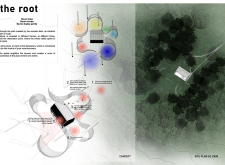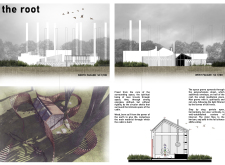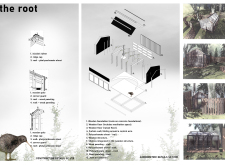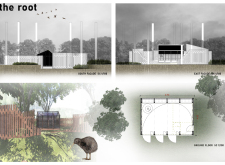5 key facts about this project
The central feature of the project is the cabin, strategically located at the midpoint of the site, which serves as a focal point for activities centered on introspection and serenity. The design creates a transition between the indoor environment and the natural landscape, promoting a connection to nature. The use of materials such as wood for the structure and polycarbonate sheets for the roofing allows the design to blend seamlessly with its natural context while maintaining durability and weather resistance.
Unique Approach to Spatial Design and Functionality
This project distinguishes itself from conventional designs by integrating a holistic approach that prioritizes the user's sensory experiences. The pathways that lead to the cabin are specifically designed as circular routes, correlating to the concept of the seven chakra points, which provide both physical and metaphysical pathways for the user. Each element within the design not only serves a physical purpose but also aims to enhance the user's mental and spiritual journey. The cabin features a series of frames that provide a dynamic perspective of the outdoor views, ensuring that the changing light conditions throughout the day influence the internal ambiance, promoting an ever-evolving experience.
Spatial transitions play a crucial role in the design. The clear distinction between enclosed spaces and open pathways facilitates a flow that encourages users to move between the various environmental contexts. This fluidity is integral to fostering mindfulness and a deeper connection to one's surroundings. Additionally, the circular shells surrounding the cabin offer shelter while creating a safe environment for users to engage in personal reflection.
Integration of Nature and Architecture
Critical to the project’s success is the careful selection of materials that enhance its aesthetic and functional goals. The predominant use of wood not only reflects a sustainable design choice but also establishes a warm, inviting atmosphere. The incorporation of polycarbonate allows for ample natural light, increasing the visibility of the surrounding landscape and creating a serene internal environment. This careful consideration of materiality amplifies the project's intent to harmonize architecture with nature.
The architectural layout encourages exploration and promotes a clear connection to the landscape. Users are invited to engage with the environment through paths that vary in texture and elevation, providing a physical experience that mirrors their emotional journey. The design effectively communicates the project's purpose: to create a setting that is both a retreat and a space for personal growth and reflection.
To gain a deeper understanding of "The Root," interested readers should explore the architectural plans, architectural sections, and architectural designs that further illustrate the project's innovative approach and thoughtful execution. By examining these elements, one can appreciate the intricate details that embody the underlying concepts and intent of this architectural endeavor.


























